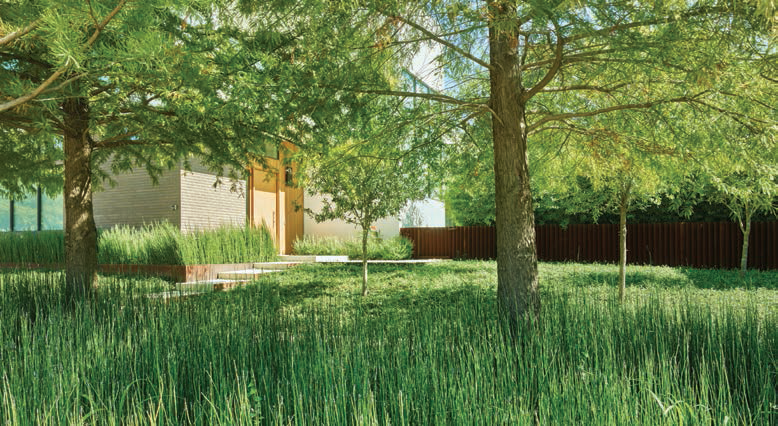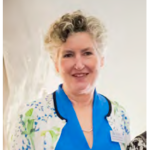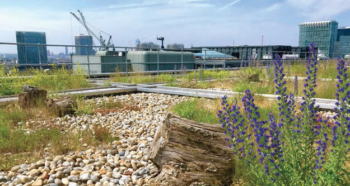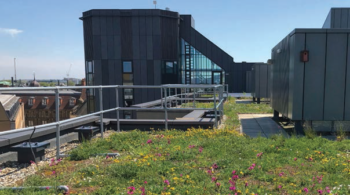Patricia Tyrrell MGLDA reviews the Garden & Landscape Designers Association’s recent seminar
At a garden design seminar, it’s not unusual to hear a discussion on plant combinations. When one of those plant combinations celebrates the beauty of nettles you know a new conversation has started. The GLDA hopes their recent seminar is the start of such a conversation, and of a movement towards rethinking how we garden. The idea has literally gone wild in newspaper articles and on social media, reverberating like an echo but hopefully more far-reaching. The GLDA would like to keep this conversation going; it’s vital for our future.
Rewilding describes a return to as close a version of wildness as can be achieved, where we share our spaces with the natural world of animals, birds, and insects. We should not be trying to constantly control nature, but to allow it space to develop and evolve. It involves creating multifunctional landscapes where everybody benefits.
The subject is important because the statistics are stark. Wild animal populations have plummeted by 60% in 44 years (WWF). Habitat loss, degradation, exploitation and the resulting climate change are the main causes. In Ireland broadleaf woodland makes up only 2% of our tree cover. Species-rich grasslands have declined by 97%.
We should not think of this as something that can be resolved on a grand scale. Two-thirds of the population are now living in urban areas. That’s a lot of gardens. Each of us has a part to play.
Probably this year more than any other, the speakers kept to the theme. This, to me, indicated their genuine passion and commitment in fighting for the environment and the urgent need to communicate their message to others. Wild plants, water conservation, rain gardens, biofiltration and green roofs, we had it all but delivered in living examples and by experts in their field.
The garden of our first speakers Monique and Thierry Dronet at Berchigranges is set in the Vosges mountains (in eastern France) at an altitude of 700 metres, and was previously a quarry and spruce plantation which Thierry painstakingly cleared to let nature in. As we plant increasing areas of the Irish countryside under these types of plantations, with the associated reduction in biodiversity, this particular garden has many lessons for us. The guiding principle behind the design is that ‘nature became a garden’. It became apparent from early in the presentation that here was a garden with that elusive quality – atmosphere.
It is a study in contrasts: the formal and the informal, the wild and the cultivated. A garden initially is about design and layout, but after that, it is about maintenance levels and development. In Berchigranges there are areas where the maintenance is almost zero and others where the garden is intensively manicured, as in the hornbeam hedge maze in their French Garden.
From left: A green roof in London providing a variety of niches for invertebrates and wildlife. A haven for pollinators, wildflowers thrive on the roof of the David Attenborough building, Cambridge.
Maintenance is less and the plants more natural in the Cottage Garden. As Monique pointed out, cottage garden plants are mutations of wild plants, some found back in the Middle Ages when nurseries did not exist. The lowest maintenance area is the moss garden. There are 200 varieties of moss, 25 of them are in this garden, slowly growing over rocks and tree roots to provide a calm green carpet. As mosses take their nutrients from the air there is no need for any inputs or maintenance here.
More recently developed is the Bohemian Garden, an experimental combination of the wild and the cultivated. Initially, this area was cleared of rock and the soil tilled. The seed was collected from the surrounding countryside. Not surprisingly the resultant mix was dominated by Epilobium angustifolium (Fireweed), a pioneer of recently disturbed ground and quite invasive. Through observation, patience and knowledge, the Dronet’s have steered the planting, adjusting, editing and adding judiciously. Some of the introductions, asters, for instance, are vigorous and capable of holding their own against the competition. Camassias and Narcissus poeticus have been added for spring.
It’s a masterclass in the use of wild plants alongside the cultivated: Succisa pratensis, with Centaurea, Sanguisorba and Filipendula, Lupinus and Alchemilla mollis, Campanula lactiflora and Veronicastrum, Monarda and nettles. It’s high maintenance, high-intensity experiment, with a particularly beautiful atmosphere like a garden gone wild. They finished their talk by exhorting the audience to give over some part of their garden to nature, and for each to play their part in supporting biodiversity.


Kevin Sloan is a Landscape Architect and urban planner who practices in Dallas, Texas, where he works in partnership with his wife Diane. He is also a writer and lecturer at the University of Texas.
It made me genuinely sad as Kevin shared with us the fact that for the most part, prairies no longer exist except in tiny pockets, gone before the plants and their biodiversity were ever studied. One might be tempted to think that back then, scientific understanding was not there to allow settlers to appreciate this environment; but then we are continuing today to render landscapes and their inhabitants extinct before they can even be studied, in our greed for timber, palm oil and other commercial crops to fuel consumer demand.
One of the projects that he shared is at Airfield Falls, one of the highest falls in this part of Dallas, where a remnant of untouched prairie landscape and the underlying Dallas-Fort Worth Branch Waters Network still remain. It was commissioned to educate people about water conservation and show them ways of adopting new practices that are less demanding on the water supply.
There are natural trails, with a picnic pavilion, a butterfly garden, and access to the creek and waterfall. The car park is designed to capture rainfall and direct it into a pond. The planting is drought-resistant. The natural beauty of the park has drawn people to the area and there is now a demand to live closer to it. The nearby goat farm will be developed as a residential area. This underpins Kevin’s arguments for rewilding. People want to live close to nature, and rewilding like this increases property values around it and has benefits for people’s overall health. His projects are achieved by selling these benefits to the decision makers.


| Ennis-based Féidhlim Harty has been running his business Féidhlim Harty Wetland Systems since 1996, focussing on the design, planning and planting of constructed wetlands, reed beds, dry toilets and zero discharge willow facilities. He has written two books on the subject, Septic Tank Options and Alternatives, and Permaculture Guide to Reed Bed, and another one on waste recycling Get Rid of Your Bin. Perhaps not your first choice for bedtime reading, but all of his books sold out subsequent to his fascinating talk on the subject. Féidhlim’s passion and commitment to his work shine through, making him a very engaging speaker.
Underpinning Féidhlim’s talk was the philosophy of permaculture. Permaculture is a set of design principles centered around whole systems thinking simulating or directly utilising the patterns and resilient features observed in natural ecosystems. “Hand in hand with rewilding green spaces and cityscapes, we need to closely examine our treatment of soil and water. The wildness is being squeezed out of them by the steady encroachment of land management practices and pollution from fields and farmyard runoff, sewage effluent and urban drainage.” Féidhlim emphasised that in order to rewild waterways, we need to look at the quality of water in those waterways and on the catchment that flows into them. He highlighted the fact that the quality of our river waters has deteriorated overall, with less than 1% of reference quality. Reed beds, constructed wetlands and willow filters can all help to reverse this deterioration. He used a farming community-led project at Pontbren in Wales as a shining example of this integrated approach. Strategic woodland and hedgerow planting, and less intensive agricultural inputs allowed the farmers to farm, but more economically. In wet areas of the farms, rather than attempt to improve the drainage of persistently wet patches of grassland the farmers chose to fence off these areas and excavate ponds. These interventions have meant that Pontbren is now home to many wild birds including 12 species of particular conservation importance – hen harrier, Skylark, linnet, barn owl, lapwing, snipe, kingfisher, curlew, red kite, cuckoo, stonechat and woodcock. The changes in tree cover and hedgerows coupled with the introduction of ponds, and dams, has moderated peak flows in the upper catchment which has led to significant reductions in downstream flooding. This is something we really need to look at in Ireland, where all our flooding solutions are engineered ones, destroying both wildlife and our cultural heritage in the process. Amongst his own projects is a tailings pond in Cork, where a low intervention approach has led to a haven for wildlife. Not all of his projects are on this scale and he also shared domestic and community-based systems such as that at Cloughjordan Eco Village in Co Tipperary. Féidhlim has also introduced zero discharge willow systems, a Danish innovation that uses a plastic lined basin, backfilled with soil and planted with willows for evaporating 100% of the effluent to air. Our final speaker was Dusty Gedge, a man whose conversations are peppered with talk of birds. His keen interest in ornithology since childhood links in beautifully and holistically with bringing nature back to the city, through green roofs. His talk looked at the man as part of the ecology and with more than 75% of the population of the EU living in cities the idea of weaving nature through and into the city, through green roofs and infrastructure. He highlighted the many benefits they bring in providing homes for invertebrates and refuge, nesting sites and food for birds. Some of the nuts and bolts were also discussed. Different types of plantings depending on the substrate. Sedum roofs are not always the ideal or the only solution and depth of soil or growing medium is critical here. In a harsh, dry and windy environment where the establishment of vegetation can be difficult, the creation of microclimates at ground level can also have a big impact on the successful establishment. CONCLUSIONDwelling on the negative reports we hear each day can lead to apathy. When researching speakers for this topic, it was felt that it was particularly important that the speakers were involved in making an impact, that the message should be a positive one on what can and is being done around the world, and that the message should be uplifting. Hopefully, our seminar has inspired others to look around and see what they can do to make a difference and to continue the conversation. ✽ |
  She can be contacted via her website at living-landscapes.com |









